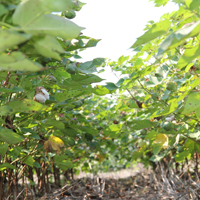The intersection of integrated pest management and soil quality in the resistant weed era

Accepted: 25 June 2021
HTML: 13
All claims expressed in this article are solely those of the authors and do not necessarily represent those of their affiliated organizations, or those of the publisher, the editors and the reviewers. Any product that may be evaluated in this article or claim that may be made by its manufacturer is not guaranteed or endorsed by the publisher.
Agricultural producers and scientists have long recognized both beneficial and detrimental aspects of soil tillage. With the development and adoption of herbicide-resistant crops, particularly glyphosate-resistant crops, herbicides such as glyphosate replaced the need for tillage either before or after crop planting. Thus, tillage has become less important for weed management and has been a primary enabler for the success of the majority of conservation production systems. Currently, herbicide-resistant and troublesome weeds are continually challenging agricultural decisions throughout the world. Conservation tillage hectarage is at constant risk of being converted to higher-intensity tillage systems due to lack of weed control. The shift to higher-intensity tillage facilitates the burial of weed seed through the use of inversion tillage and/or of surface tillage to facilitate pre-plant incorporated and pre-emergence herbicides for control of herbicide-resistant or troublesome weeds, especially in non-irrigated production. For example, Palmer amaranth (Amaranthus palmeri) has become the dominant weed problem in United States row crop production because of evolved resistance to glyphosate. Inversion tillage was clearly demonstrated to be an effective tool in helping the management of this weed. However, there is no question that most tillage operations promote soil loss, adversely affect (lower) surface water quality, and negatively impact soil productivity. Depending on the severity of the herbicide-resistant or troublesome weed infestation, multiple strategies involving the integration of cultural and chemical weed control will be needed to overcome the need for tillage. Utilizing high biomass conservation tillage systems, such as those used extensively in South America and introduced to the United States, can help reduce the emergence of weeds by suppressing weed germination and growth. A dense mat is formed on the soil surface when the winter cover crop is planted early and managed for maximum growth. Because weed emergence and growth are suppressed by the physical barrier and shading provided by the residue, more residue increases weed control. Conservation tillage systems that minimize soil disturbance (direct seeding or minimum tillage) can further reduce weed seed germination. In addition, allelopathy plays a role in weed suppression, but quantifying allelopathic effects in applied research is rarely accomplished. Creative research programs have been developed that meet conservation compliance requirements and, at the same time, judiciously use tillage as an element for the management of resistant or troublesome species. Similar programs are needed to help manage herbicide-resistant or troublesome weed species in other regions and cropping systems. Further research is critically needed when few or no other options are available to ensure the economic viability of farming operations while addressing long-term soil quality concerns.
Highlights
- Conservation tillage hectarage is at constant risk of being converted to higher-intensity tillage systems due to lack of weed control.
- Most tillage operations promote soil loss, adversely affect surface water quality, and negatively impact soil productivity.
- Creative research programs have been developed that meet conservation compliance requirements and, at the same time, judiciously use tillage as an element for the management of resistant or troublesome species.
- Further research is critically needed when few or no other options are available to ensure the economic viability of farming operations while addressing long-term soil quality concerns.
How to Cite

This work is licensed under a Creative Commons Attribution-NonCommercial 4.0 International License.
PAGEPress has chosen to apply the Creative Commons Attribution NonCommercial 4.0 International License (CC BY-NC 4.0) to all manuscripts to be published.

 https://doi.org/10.4081/ija.2021.1875
https://doi.org/10.4081/ija.2021.1875



